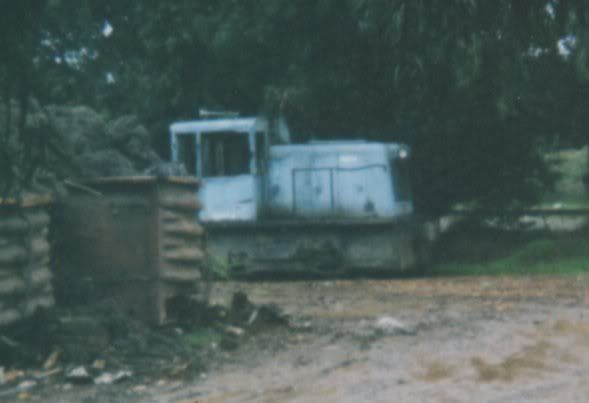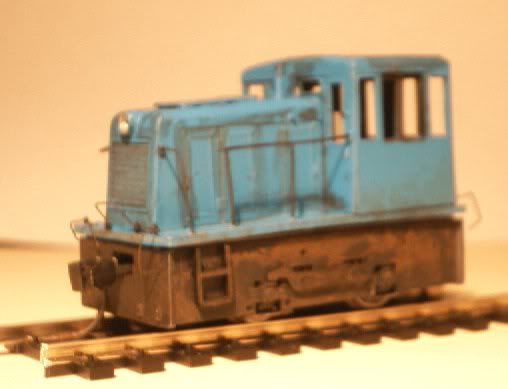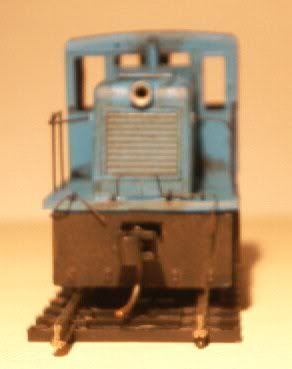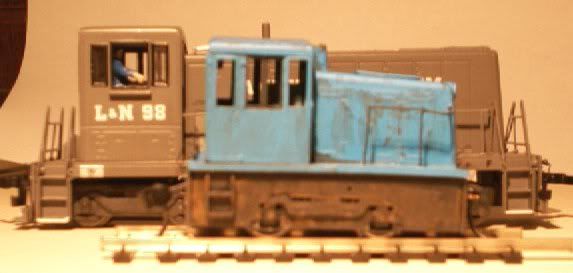For a few years, I have been struck with the idea of building a model of a small industrial locomotive that operates here in Sacramento--a 25 ton General Electric diesel-electric, operated by Simsmetal wrecking yard. I have seen it quite a few times inside the yard, and have risked hassling by employees to stick my camera through holes in the fence to snap some shots of this adorable little robin's egg blue beastie:

In the foreground are two old gon bodies used to hold something brown, rusty and probably unpleasant.
After some searching around and an instructive but essentially unsuccessful kitbash of a 44 tonner, I finally located the Grandt Line 25 ton end cab locomotive kit at a hobby shop in Chicago. I finished it up (except for an air horn, windows and couplers) this evening. It is definitely the tiniest HO scale locomotive I have ever built. As kits go it was pretty simple to assemble, although the tiny sizes of everything definitely pushed the limits of my dexterity and briefly made me consider switching to LGB scale. I broke a couple of the handrails but was able to improvise with some wire, and was happy to realize that the handrails on the prototype I am modeling are kind of banged up anyhow.


Here's a comparison shot with a General Electric 70 tonner, normally considered a fairly tiny locomotive:

I still need to get some Kadee #711 couplers. I just stuck a pair of #5s in the coupler holes for now, but they aren't actually attached to anything. So, I haven't been able to test its pulling power, tho I suspect it is not good for pulling more than a couple of cars--I suspect the prototype isn't much of a monster mover either. It does have a very good gearing-reduction system--going flat-out it runs at about 25-30 scale MPH. Not super smooth, but it's kind of amazing that something this dinky runs at all. If I can find a lighting kit small enough to install (there is just about NO free space) inside I might try to install headlights...other than that, I think the best possible improvement might be to find a couple of HO scale white-metal figurines to put in the back, because a metal figurine would add a little weight and improve running...one thing I noticed in test runs is that the infinitesimal weight of the locomotive body noticeably improves the tracking characteristics of the locomotive. I don't think I could get much in the way of weight into the body of the loco, but a couple of metal miniatures might work just as well.

In the foreground are two old gon bodies used to hold something brown, rusty and probably unpleasant.
After some searching around and an instructive but essentially unsuccessful kitbash of a 44 tonner, I finally located the Grandt Line 25 ton end cab locomotive kit at a hobby shop in Chicago. I finished it up (except for an air horn, windows and couplers) this evening. It is definitely the tiniest HO scale locomotive I have ever built. As kits go it was pretty simple to assemble, although the tiny sizes of everything definitely pushed the limits of my dexterity and briefly made me consider switching to LGB scale. I broke a couple of the handrails but was able to improvise with some wire, and was happy to realize that the handrails on the prototype I am modeling are kind of banged up anyhow.


Here's a comparison shot with a General Electric 70 tonner, normally considered a fairly tiny locomotive:

I still need to get some Kadee #711 couplers. I just stuck a pair of #5s in the coupler holes for now, but they aren't actually attached to anything. So, I haven't been able to test its pulling power, tho I suspect it is not good for pulling more than a couple of cars--I suspect the prototype isn't much of a monster mover either. It does have a very good gearing-reduction system--going flat-out it runs at about 25-30 scale MPH. Not super smooth, but it's kind of amazing that something this dinky runs at all. If I can find a lighting kit small enough to install (there is just about NO free space) inside I might try to install headlights...other than that, I think the best possible improvement might be to find a couple of HO scale white-metal figurines to put in the back, because a metal figurine would add a little weight and improve running...one thing I noticed in test runs is that the infinitesimal weight of the locomotive body noticeably improves the tracking characteristics of the locomotive. I don't think I could get much in the way of weight into the body of the loco, but a couple of metal miniatures might work just as well.


